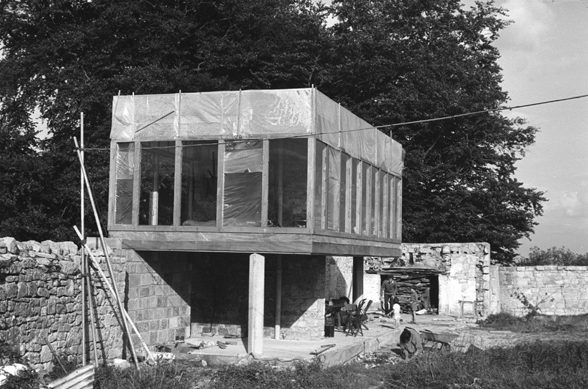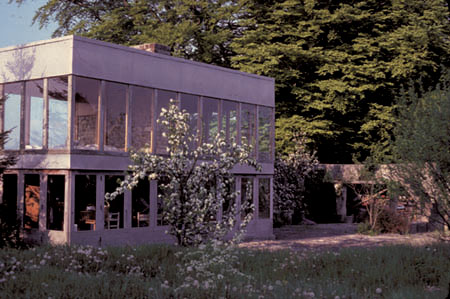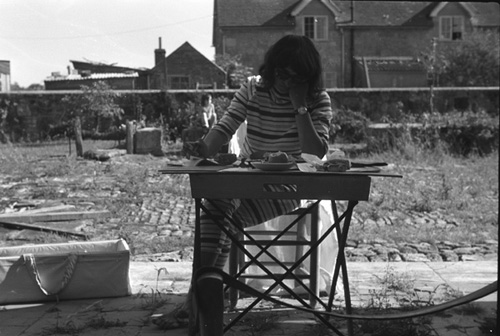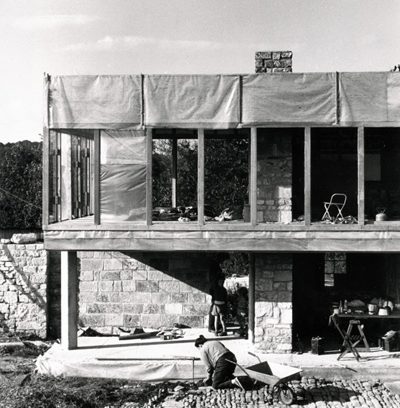This website uses cookies
This website uses cookies to enable it to function properly and to analyse how the website is used. Please click 'Close' to accept and continue using the website.






August 2004 - Alison & Peter Smithson’s Upper Lawn Pavilion
Images courtesy of the Smithson Family Archive, featured in edited by Dirk van den Heuvel and Max Risselada, published by 010 Publishers, Rotterdam 2004
Issues of theory and practice too often divide the architecture community into two camps snubbing each other, quite unnecessarily, since the two are interdependent. Architect’s homes provide rare occasions where the two find a natural symbiosis. The Smithsons’ weekend home in Wiltshire belongs to that species in more than one sense, because not only did they build their ideas as concretely as possible, they also built themselves a private place for retreat and reflection.
The Upper Lawn Pavilion that Alison and Peter Smithson realised is actually nothing more than a primitive hut. It is just comfortable enough for Londoners to flee their daily environment to enjoy the outdoor country life. To this end the Smithsons acquired part of a farmstead in Wiltshire that consisted of a large walled yard with a labourer’s cottage built into the northern wall. The best part of the cottage was pulled down to replace it with a new and modest pavilion, answering their needs for a weekend home. Of the original front façade, only one of the old chimneys was left intact to function as the centre of the new pavilion.
The new pavilion was conceived as a simple box on top of the existing garden wall. It contains an empty and open living space, providing a fabulous, panoramic view of the surrounding land. The space underneath the box is for all conveniences and the kitchen-diner. This more intimate area faces the yard; pushing the sliding doors to the side will fully open the kitchen-diner to the garden space and a large terrace.
The pavilion’s hybrid construction fits with the interventions made and the incorporation of existing elements like the garden wall, the chimney, as well the windows of the former cottage. The construction of the box on the wall consists of a wooden frame clad with zinc. On all sides its posts function as casing for fitted windowpanes. The frame’s wooden beams are put in the existing outer wall and supported on the inside by a concrete beam poured in-situ and anchored in the existing chimney wall, and, on both ends, by square columns placed at a 45 degree angle. This construction results in non-supporting ground level façades, allowing the creation of the teak sliding doors along the full length of the garden façade.
Mies’ tectonics and Le Corbusier’s pilotis and free façade are joined and transformed here, aiming for a full simplicity and directness, thus demonstrating the architectural programme of New Brutalism advocated by the Smithsons in those years.
In 1982, the Smithsons felt forced to sell their country place because of the noise produced by new neighbours, sound engineers from London now occupying the adjoining yard and house. During the following years however, they continually reflected upon occupying the pavilion. Alison Smithson, together with Enric Miralles, published these reflections in the poetic compilation , during the time she was teaching in Barcelona (1985-86). Peter’s extensive photographic record of the construction and occupation of Upper Lawn is an important constituent of the publication. Mies van der Rohe’s Barcelona Pavilion was being reconstructed at the time, reason for Alison to suggest Upper Lawn might be its ‘New Brutalist grandchild’.
Two years ago the Upper Lawn Pavilion was renovated by its new owners Ian and Jo Cartlidge, a job performed well by architects Sergison Bates. Its success is proof of the vitality of the Smithsons’ art of inhabitation.
www.thelighthouse.co.uk or ring +44 (0) 141 221 6362.
Look for past Buildings of the Month by entering the name of an individual building or architect or browsing the drop down list.

Become a C20 member today and help save our modern design heritage.